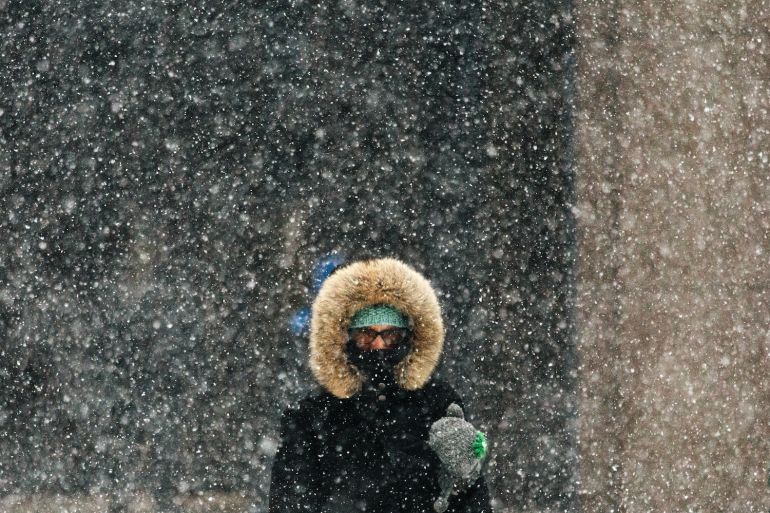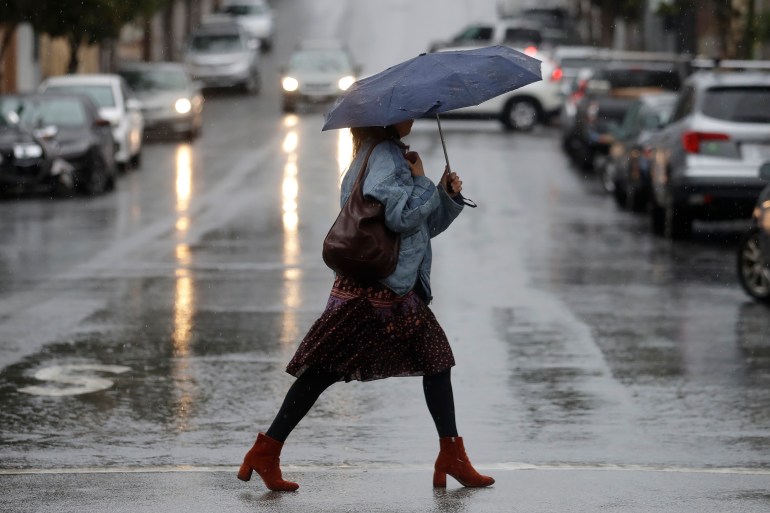Heavy snow and plunging temperatures: What is a bomb cyclone?
The United States braces for a cold snap as wind chill temperatures could drop to dangerous levels far below zero.

An Arctic blast is bringing extreme cold, heavy snow and intense wind across much of the United States this week – just in time for the holidays.
The weather system, which may build into a “bomb cyclone,” is expected to move east in the days leading up to Christmas, disrupting travel and causing hazardous winter conditions. Where is this winter weather coming from, and what is in store for the coming days?
Keep reading
list of 3 itemsUS winter storm expected to collide with peak holiday travel
Heavy snow disrupts UK travel after this year’s coldest night
What is happening?
A front of cold air is moving down from the Arctic, sending temperatures plunging.
Much of the US will see below-average temperatures through the middle and end of the week, said Bob Oravec, the lead forecaster for the National Weather Service in College Park, Maryland.
Temperatures may drop by more than 11 degrees Celsius (20 degrees Fahrenheit) in just a few hours, the National Weather Service predicts.
And with winds also expected to pick up, wind-chill temperatures could drop to dangerous lows far below zero – enough to cause frostbite within minutes.

What is a bomb cyclone?
A bomb cyclone, which comes from the meteorological term “bombogenesis”, is when atmospheric pressure falls very quickly – at least 24 millibars within 24 hours.
In other words, this means that a storm is intensifying fast, which can have more devastating effects than the results of a weaker storm.
Why is this happening?
It all started farther north, as frigid air collected over the snow-covered ground in the Arctic, said Ryan Maue, a private meteorologist in the Atlanta area.
Then the jet stream – wobbling air currents in the middle and upper parts of the atmosphere – began pushing this cold pool down into the US.
As this Arctic air is pushed into the warmer, moister air ahead of it, the system can quickly develop into serious weather.
These severe weather events usually form over bodies of water, which have lots of warmth and moisture to feed the storm, Maue said. But with the huge amount of cold air coming through, we could see a rare bomb cyclone forming over land.
Whether this storm technically qualifies as a bomb cyclone depends on how quickly the pressure drops – but either way, the snowfall plus high winds will make for an intense bout of winter weather.
Who will be affected?
Pretty much everyone east of the Rockies – about two-thirds of the country – will see extreme weather in the coming days, said Maue.
Though much of the West Coast will be shielded from the cold, the Arctic front is expected to pass east and south all the way through Florida.
As for the snow, those in the Midwest will probably see a “heck of a storm,” though blizzard conditions are not expected to hit the East Coast, Maue said. Some spots around the Great Lakes may see upwards of a foot of snow by Friday, the National Weather Service predicted.
Heavy snowfall and intense winds could be bad news for travel, Oravec said. Airports in the Midwest, including the travel hub of Chicago, will likely face shutdowns as the blizzard comes through later in the week.
How long will it last?
This weather system is expected to bring some extensive “weather whiplash,” said Judah Cohen, a winter storm expert for Atmospheric Environmental Research.
The cold is not going to stick around for long. After the dramatic plunge that will keep temperatures low for about a week, “everything will snap back to normal,” Cohen said.
Shortly after Christmas, temperatures will start to warm up again, moving from west to east.